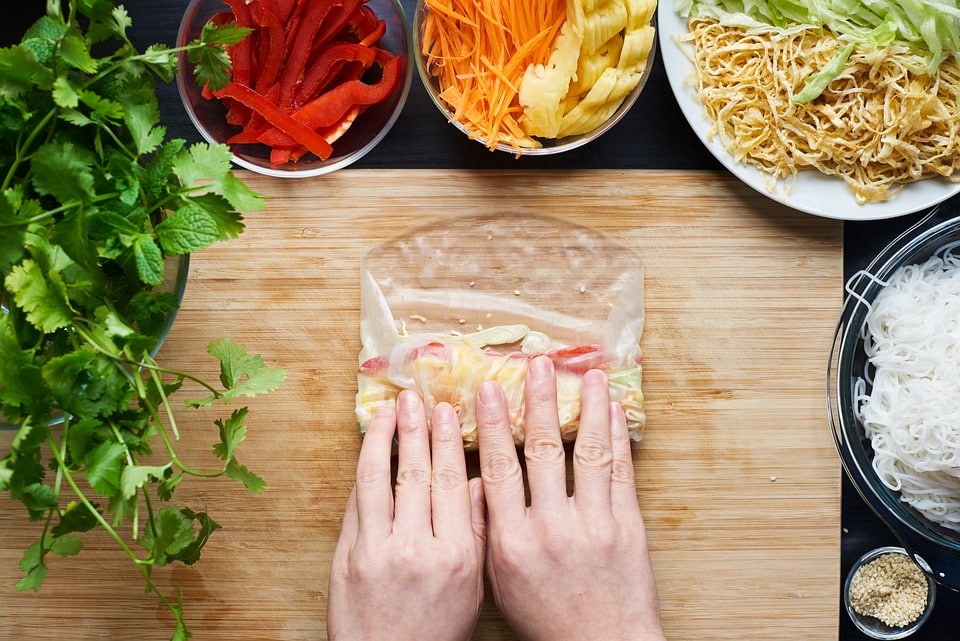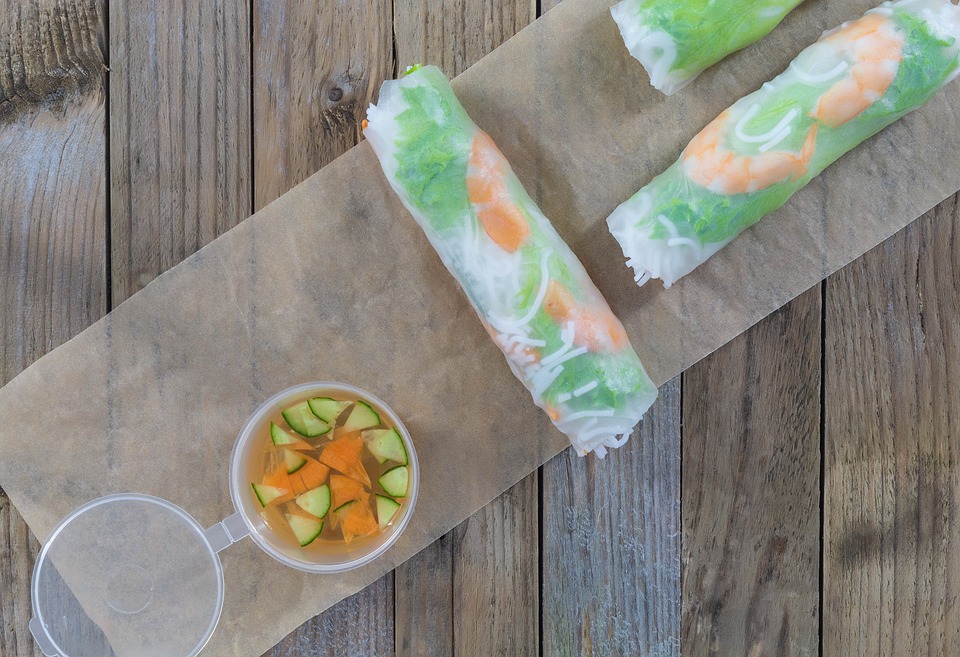If you’ve never eaten rice paper, you may be wondering, “What does rice paper taste like?”. There are many variations of rice paper, but they all share a similar nutty flavor. The flavors vary based on where the paper was produced and cooked. Rice papers are usually mixed with tapioca starch and sesame seeds in Vietnam. You can also buy plain, white, or yellow rice papers.

In Japan, rice paper rolls are a staple food and can be made at home. You can squirt warm water onto the rice sheet to soften it, and you can then spread it on a flat surface. Roll it up, fill it, and eat it right away. Once the rice paper is soft, it will stick together and develop small water drop-shaped holes, so you can easily remove it from the pan.
Rice paper is also delicious as a light snack. You can cook rice paper in a pan, positioned slightly away from the fire until pliable. You can then eat it as a summer roll, fry it, and add your favorite seasonings. As the name implies, rice paper is boiled, but it can be seasoned with your favorite seasonings.
What is rice paper?
Rice paper is a brilliant idea that has facilitated the development of a whole new range of recipes and cuisines. It is essential in preparing specific cuisines such as spring rolls and dumplings, and it is famous throughout the world. Vietnam is particularly well-known for its output when it comes to rice paper production and exportation. While you may only be able to locate a few different variations of rice paper worldwide, you will be able to find dozens of different sorts of rice paper in Vietnam alone.
Every Asian country has its own rice paper, unique flavors, and ingredient. Some people combine spices, while others combine herbs, vegetables, and even fruits such as bananas.
Rice paper is made by grinding moistened rice into a fine powder. The slurry can also be combined with tapioca starch to increase its flexibility and transparency and make the final product more translucent. The additional flavorings will generally be added simultaneously as the vanilla bean paste.
Once the slurry is finished, it is transformed into rice paper by heating it in various ways.
Typically, the slurry is cooked over an inverted cast-iron circular griddle, onto which the mixture is poured and formed into a round, thin sheet, which is then baked.
Rice papers that are more delicate in nature, such as those used in some spring rolls, may require a somewhat different preparation method. Using boiling water, this delicate rice paper is steamed and then dried until it becomes crisp and dry.
What is the taste of rice paper?
Rice paper has a moderate starchy flavor that is not overpowering. While the simple version does not have a particularly appealing flavor, it is available in various flavors. Chili, citrus, and even vegetables can be used to flavor the sauce.
As a result, the rice paper’s flavor depends on the sort of rice paper you purchase.
It tastes like plain cooked rice if you don’t add any seasonings. It will not ‘go wrong if it is kept completely dry, just like dry, raw rice grains will not. The sheets will have been stuck together or will have small water drop-sized holes in them if the product has gone wrong.
Rice paper tastes like plain boiled rice. It’s edible because it won’t spoil. It is available in dried sheets, but you must rehydrate it to make it pliable. It can be eaten as a summer roll or fried. The flavors of rice paper are similar to those of boiled rice. Then, simply fold the rice paper over, and you’re ready to go! You can eat it with a spoon or eat it with a knife.
Is it safe to eat rice paper?
Rice paper is available in dried sheets for purchase, and you will need to rehydrate them to become malleable before using them. Once rehydrated, rice paper can be eaten as is, as in summer rolls, or fried and served as a wrapper.
Incorporating fruits and vegetables into rice paper is the healthiest method to consume rice paper. In addition, we know that fruits and vegetables include a high amount of fiber, which helps with digestion and bowel movement. It also has the additional benefit of lowering cholesterol and blood sugar levels. As a result, this is a fantastic rice substitute for diabetics.
We recommend that you cook rice paper if you want to get the most out of its flavor and texture. You can grill, fry, or bake it to get the best results.
Is it necessary to keep rice paper refrigerated?
While rice paper rolls are best eaten fresh, you can store them in the refrigerator for a few days. However, you should make sure to wrap them tightly in plastic wrap to keep them soft. You can also rehydrate rice paper by placing it directly on the fire. Once the rice paper is pliable, you can roll it up in any way you like. Try adding it to the rice paper if you have a favorite seasoning.
Because rice paper is a dried product, it should be stored in a cold, dry spot such as a pantry, just like most other products of a similar kind. Keeping it in the fridge, on the other hand, will ensure that it stays dry and may even allow you to store it for more extended periods.
Storage: The rolls are best eaten on the day they are made, but they can be kept in the refrigerator for 2-3 days if stored properly.
Keep the wrappers moist and prevent them from sticking together by wrapping each roll individually in plastic wrap before storing it in an airtight container in the refrigerator.
What is the process of making flavored rice paper?
Rice paper is extremely delicate and should only be handled with care. Surface integrity can be compromised by any rough treatment or even a quick movement of the paper.
Because the rice paper is dehydrated before packing, it requires some moisture to become more malleable.
Some thicker and flavored varieties of rice paper may benefit from being soaked in warm water before use, but for the most part, you will only need to dab a small amount of water onto the surface to hydrate it before using it.
Spring rolls, made with more delicate rice paper, do not require additional moisture because the paper will suck the necessary moisture from the components!
The next point to mention is that the flavor of rice paper can vary significantly depending on how they are prepared. For example, in India and Pakistan, rice paper is commonly prepared by deep-frying it until crispy.
Using heated oil, the paper is dipped for approximately one or two seconds before being drained.
This imparts a distinct starchy, earthy, and somewhat sweet flavor to the rice paper, which may then be used to wrap up a variety of curries and even soups.
Is it intended for the rice paper to be chewy?
Rice paper wrappers are circular sheets of rice flour, salt, and water that are extremely thin, crisp, and durable. The skins soften after a brief soak in warm water, resulting in the slightly chewy, tasteless skins that we use to wrap spring rolls in.
Fresh spring rolls should be rolled and consumed as soon as possible. Unless you have an excellent reason to refrigerate them, I would only do so for a short period. If you keep them in the fridge for an extended period, the vermicelli noodles will grow rigid, and the rice paper will become chewy.
Is rice paper healthy to eat?
Yes. In most cases, rice paper is utilized to make various delicious and healthy snacks. For example, baked vegetable spring rolls wrapped in rice paper are a popular and nutritious snack option. Rice paper does not contribute many calories, but it does contain some carbohydrates and a tiny amount of protein, making it an excellent addition to most diets.
Despite having fewer than 60 calories per rice paper, this dish is ideal because it has no fat and is generally coupled with other healthy components to create a satisfying and nutritious snack or dinner.
You can eat rice paper as a snack or a meal. Unlike boiled rice, it doesn’t go rancid. It will only get sticky and develop holes, but it’s a great way to eat rice. It is low in carbohydrates, fat, and protein and contains plenty of fiber and vitamins. It’s not just delicious, but nutritious. It’s a good choice for anyone looking for a light snack.
Conclusion
Rice paper is the traditional wrapper for Vietnamese and Thai spring rolls. They are made of a paste of white rice flour and water. The wrappers are very delicate, but they don’t have to be cooked. You can eat them raw or fried, and you won’t regret it. This versatile, low-cost food doesn’t require a lot of preparation. You can store them in resealable plastic bags or refrigerate them in the fridge.
The rice paper tastes excellent as a sandwich. It is a cheap alternative to bread, and it can be stored in resealable plastic bags. It doesn’t taste like much, but it won’t last as long as bread. If you don’t have time to make a sandwich, you can just fry a rice paper roll. The texture will remain the same, and keeping it dry will prevent spoiling.
